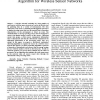Free Online Productivity Tools
i2Speak
i2Symbol
i2OCR
iTex2Img
iWeb2Print
iWeb2Shot
i2Type
iPdf2Split
iPdf2Merge
i2Bopomofo
i2Arabic
i2Style
i2Image
i2PDF
iLatex2Rtf
Sci2ools
INFOCOM
2003
IEEE
2003
IEEE
An Energy Efficient Hierarchical Clustering Algorithm for Wireless Sensor Networks
— A wireless network consisting of a large number of small sensors with low-power transceivers can be an effective tool for gathering data in a variety of environments. The data collected by each sensor is communicated through the network to a single processing center that uses all reported data to determine characteristics of the environment or detect an event. The communication or message passing process must be designed to conserve the limited energy resources of the sensors. Clustering sensors into groups, so that sensors communicate information only to clusterheads and then the clusterheads communicate the aggregated information to the processing center, may save energy. In this paper, we propose a distributed, randomized clustering algorithm to organize the sensors in a wireless sensor network into clusters. We then extend this algorithm to generate a hierarchy of clusterheads and observe that the energy savings increase with the number of levels in the hierarchy. Results in st...
| Added | 04 Jul 2010 |
| Updated | 04 Jul 2010 |
| Type | Conference |
| Year | 2003 |
| Where | INFOCOM |
| Authors | Seema Bandyopadhyay, Edward J. Coyle |
Comments (0)

